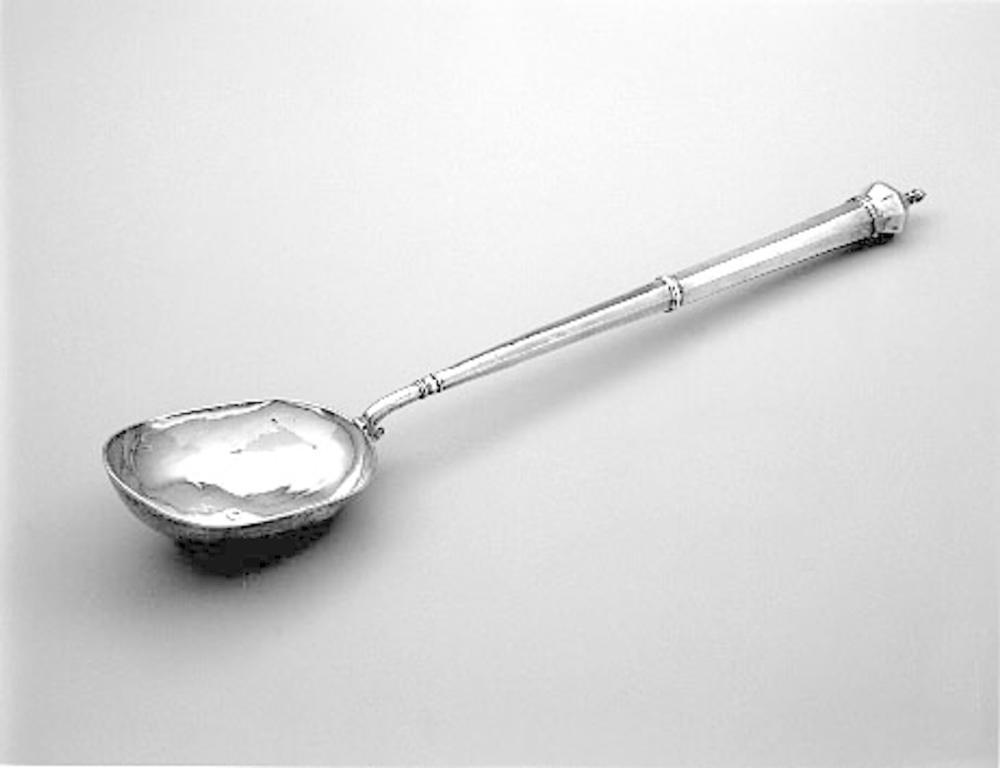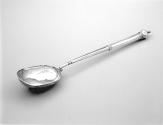Advanced Search
Serving Spoon
John Edwards (American, about 1671–1746)
about 1725
Object Place: Boston, Massachusetts
Medium/Technique
Silver
Dimensions
8.1 x 46 cm (3 3/16 x 18 1/8 in.)
Credit Line
Museum purchase with funds donated by a friend of the Department of American Decorative Arts and Sculpture
Accession Number1985.411
CollectionsAmericas
ClassificationsSilver flatware
Few examples survive of early-eighteenth-century monumental serving spoons. Although it is difficult to identify the various forms and purposes of these utensils, such as this example by John Edwards, Kathryn C. Buhler suggests they may have been called goose spoons, for the purpose of serving stuffing; basting or ragout spoons; and hash spoons. Since all these tasks involved working with hot foods, the spoon’s unusually long, hollow handle would have offered the server some protection from heat. Their usefulness at the dinner table can also be inferred by one known English example that conceals a marrow scoop within its removable handle.
Serving spoons with hollow octagonal handles and crownlike faceted finials were also made by Jacob Hurd (MMA) and William Homes Sr. (1716/17 – 1785). Both are closely related to the Edwards spoon, although each lacks the distinctive hook between the bowl and handle. Slightly smaller examples with hollow circular, or “cannon,” handles were made by Peter Van Dyck (1684 – 1750/51) and Edward Winslow; a later example by Benjamin Burt in the Museum’s collection is an updated version of these spoons and features a more attenuated handle and a shell motif on the back of the bowl.
These large spoons, with their deep oblong bowls, also may have served as early punch ladles. Charles Jackson illustrated a closely related Irish example made in 1702 and speculated that, in addition to serving hash or “Irish stew,” the spoons were probably used to ladle large quantities of punch into a jug used at the table for filling drinking glasses. The introduction in the 1740s of smaller ladles with deeper bowls set at right angles to the handle, more suitable for pouring, coincided with a trend to drink more potent punch in lesser quantities.
Buhler also theorized that the prominent hook at the junction of the handle and bowl was used to rest the spoon on the edge of a punch bowl; however, the implement’s length seems to prevent such a use. The hook allows for the spoon to be hung vertically, with its bowl pointing upward. Perhaps it provided a way to store this oversized and somewhat awkward implement in a cabinet or kitchen setting. A serving spoon by Benjamin Burt, made about 1750, included a ring at the end of the handle for this purpose.
This text has been adapted from "Silver of the Americas, 1600-2000," edited by Jeannine Falino and Gerald W.R. Ward, published in 2008 by the MFA. Complete references can be found in that publication.
Serving spoons with hollow octagonal handles and crownlike faceted finials were also made by Jacob Hurd (MMA) and William Homes Sr. (1716/17 – 1785). Both are closely related to the Edwards spoon, although each lacks the distinctive hook between the bowl and handle. Slightly smaller examples with hollow circular, or “cannon,” handles were made by Peter Van Dyck (1684 – 1750/51) and Edward Winslow; a later example by Benjamin Burt in the Museum’s collection is an updated version of these spoons and features a more attenuated handle and a shell motif on the back of the bowl.
These large spoons, with their deep oblong bowls, also may have served as early punch ladles. Charles Jackson illustrated a closely related Irish example made in 1702 and speculated that, in addition to serving hash or “Irish stew,” the spoons were probably used to ladle large quantities of punch into a jug used at the table for filling drinking glasses. The introduction in the 1740s of smaller ladles with deeper bowls set at right angles to the handle, more suitable for pouring, coincided with a trend to drink more potent punch in lesser quantities.
Buhler also theorized that the prominent hook at the junction of the handle and bowl was used to rest the spoon on the edge of a punch bowl; however, the implement’s length seems to prevent such a use. The hook allows for the spoon to be hung vertically, with its bowl pointing upward. Perhaps it provided a way to store this oversized and somewhat awkward implement in a cabinet or kitchen setting. A serving spoon by Benjamin Burt, made about 1750, included a ring at the end of the handle for this purpose.
This text has been adapted from "Silver of the Americas, 1600-2000," edited by Jeannine Falino and Gerald W.R. Ward, published in 2008 by the MFA. Complete references can be found in that publication.
DescriptionThis large serving spoon, with deep elliptical bowl, has a long handle made of two sections seamed lengthwise and bound laterally with three soldered midbands. The handle is octagonal, tapering toward a deep elliptical bowl. The handle tip is likewise faceted, having a tall pawn or crown-shaped finial soldered to the handle with midband decoration. Small circular air vents appear on the back, at the base of the handle tip and below the midband. A small midband and C-scroll hook connect the handle with the rattail bowl.
Marks
Marked on back of bowl, at center, "I E" crowned over a fleur-de-lis, within a shield-shaped cartouche.
InscriptionsEngraved "W / I A" in shaded roman letters on back of bowl, above mark.
ProvenanceBy 1948, purchased by Mark Bortman (1896-1967); 1948, loan by Mr. Bortman to the MFA. 1968, by inheritance to his daughter, Jane Bortman Larus, Bortman-Larus Americana Foundation; 1985, sold by Bortman-Larus through William Duffy to the MFA. (Accession date: September 24, 1985)



